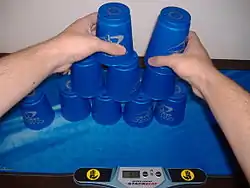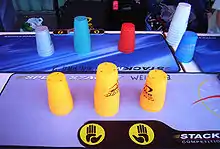Sport stacking
Sport stacking, also known as cup stacking or speed stacking, is an individual and team sport that involves stacking 9 or 12 (usually 12) specially designed cups in pre-determined sequences as fast as possible. The cups are specially designed to allow for speedier times. Participants of sport stacking stack cups in specific sequences, by aligning the inside left lateral adjunct of each cup with that of the next. Sequences are usually pyramids of 3, 6, or 10 cups. Players compete against the clock or another player.
 A 1-10-1 being upstacked as part of the cycle stack | |
| Highest governing body | World Sport Stacking Association |
|---|---|
| Nicknames | Cup stacking, speed stacking |
| First played | 1981, Oceanside, California, U.S.[1] |
| Registered players | 618,394 (number of worldwide participants in the Guinness World Record set in 2015)[2] |
| Characteristics | |
| Contact | No |
| Team members | Individual, doubles, teams of 4 or 5 |
| Mixed gender | Yes, but in separate divisions |
| Type | Indoor, Outdoor |
| Equipment | Cups, mat, timer |
| Presence | |
| Country or region | Worldwide |
| Olympic | AAU Junior Olympic Games |
The governing body setting the rule is the World Sport Stacking Association (WSSA).[3]
History
While working for the Boys & Girls Club of Oceanside, California in 1981, Wayne Godinet came up with the idea for sport stacking. When the children he was working with were tired of playing traditional sports, he took paper cups and asked them to stack the cups as fast as they could. The sport was well received, so Godinet decided to acquire plastic cups to be used by his club. He quickly discovered that his new plastic cups would stick together, so Godinet modified the cups by adding a hole to the bottom of the cups. He formed his own company, Karango Cupstack Co., which manufactured and distributed these modified cups in a variety of colors. By the end of the decade, Godinet estimated he had sold approximately 25,000 sets of cups. During the 1980s, Godinet hosted the annual National Cupstacking Championship in Oceanside. One of the national champions was Matt Adame, a member of Godinet's club, the "Professional Cupstack Drill Team". In November 1990, Adame and his teammates were featured on The Tonight Show Starring Johnny Carson.[1][4][5]
After the sport received national attention on The Tonight Show, Bob Fox, a physical education teacher from Colorado, introduced stacking to his students. Fox's enthusiasm led to the creation of the annual Colorado state tournament in 1997. In 1998, Fox, together with Larry Goers, created a line of proprietary sport stacking products including the patented timing system known as the StackMat.[6] Fox started traveling across the country in 2000 to promote Speed Stacks full-time.[7][8] In 2001 Fox founded the World Cup Stacking Association (WCSA) to formalize the sport's rules and sanction competitions worldwide.[9] As the sport began to spread to neighboring states, the WCSA hosted the first Rocky Mountain Cup Stacking Championships, where Fox's daughter, Emily Fox, broke her own world record by completing the cycle in 7.43 seconds.[10] The next year, the first WCSA World Championship took place at the Denver Coliseum and has since been held annually. The WCSA formally titled the sport "sport stacking" and changed their name to the World Sport Stacking Association (WSSA) in 2005. The WSSA cited the public recognition that stacking is considered a sport as the reason for the name change.[11][12]
Equipment

Official sport stacking cups are specially designed to prevent sticking and to allow the competitor to go faster. The cups are reinforced with several ribs on the inside which separate the cups when they are nestled. The exterior is slightly textured to allow better grip. The insides are very smooth and slide past each other easily. The tops of the cups have 1-4 holes to allow ventilation so the cups do not stick. One special line of cups has cups without tops to further decrease air resistance.
StackMat timers are used for official tournament timing, as well as casual play timing or practice timing.
Special weighted training cups, called "Super Stacks," are made from metal and are most commonly used directly before competing. The added weight is intended to make the regular cups feel lighter.[13]
Jumbo Stacks are a bigger version of the original speed stacks cups. They are used more commonly in P.E. classes rather than at home.
Rules
There are three sequences stacked in official sport stacking events, that are defined by the rule book handed out by the WSSA:[14]
- 3-3-3: Uses nine cups. This sequence consists of three sets of three cups each. The three sets must be stacked going from left-to-right or right-to-left, and then down-stacked into their original positions in the same order as the up-stack.
- 3-6-3: Uses 12 cups. This sequence is similar to the 3-3-3, except a six stack replaces the three stack in the middle. Each pile of cups is stacked up from left-to-right or right-to-left, and the down-stack occurs in the same order.
- Cycle: Uses 12 cups. This is a sequence of stacks in the following order: a 3-6-3 stack (see above), a 6-6 stack (two pyramids of six cups stacked up and down into one containing all twelve cups altogether) and a 1-10-1 stack (a pyramid of ten cups in the middle), finishing in a down stacked 3-6-3.
Common for all sequences are these major rules:[14]
- You may not up-stack two pyramids at the same time, but in the down-stack, it is okay to touch two stacks at the same time.
- If a stack is not completed correctly (such as when a cup or cups falls off the pyramid, considered a "fumble")[15] you must correct it immediately. The only exception to this rule is if the cups fall over during the down-stack. If this happens, the player may continue the down-stack normally and correct the fallen stack when you reach it.
There are three main categories of competing that WSSA-sanctioned tournaments offer:
- Individual: Each competitor is allowed two warm-ups and three timed tries for each sequence. The best time for each sequence is recorded and compared with other competitors. In the case of a tie, the second-best times are used.
- Doubles: Two competitors stand side-by-side to complete the stack, with one competitor using only his or her right hand while the other using only his or her left hand. The same rules for individuals apply here. The only official doubles event is the Cycle (with the exception of the "Special Stackers" category, where only the 3-6-3 is offered).
- Relay: Four competitors take turns stacking at a table, switching when the preceding competitor crosses the foul line with at least one foot. The foul line is observed by a line judge, who decides whether or not this rule was followed. The 3-6-3 relay is the only official event; however, some tournaments offer head-to-head (best 2 out of 3) 3-6-3 and Cycle relays. There are no warm-ups in this event.
Benefits
Proponents of the sport say participants learn cooperation, ambidexterity and hand–eye coordination.
A university study by Brian Udermann, currently at the University of Wisconsin-Lacrosse, confirms that stacking improves hand–eye coordination & reaction time by up to 30% (published in the scientific Journal "Perceptual and Motor Skills" in 2004)[16]
An EEG-study by Melanie A. Hart, Ph.D. Assistant Professor Department of Health, Exercise and Sports Sciences at the Texas Tech University support the claim that cup stacking does utilize both sides of the brain. During the left-hand condition, activity in the right hemisphere was larger than the left, while for the right-hand task, the left hemisphere was greater than the right. Their scientific poster on that topic got awarded by the AAHPERD[17][18] On the other hand, Hart couldn't get the same results as Udermann when studying improvement on reaction time.[19]
Gibbons, E., Hendrick, J. L., & Bauer, J. State University of New York studied the effects on the reaction time and confirmed Udermann rather than Hart, stating "that the results agreed with the claims made by Speed Stacks, in which practicing cup stacking can improve reaction time.[20] They also state "Even 1 hour of cup stacking practice can improve reaction time in young adults." Speed stacking was also seen as helping people improve in other sports because it helps to improve the hand-eye coordination.
The Department of Kinesiology at Towson University studied the influence of participation in a 6-week bimanual coordination program on Grade 5 students' reading achievement with Sports Stacking being the bimanual activity. In a pilot study, a significant increase was found for the experimental group on comprehension skills, suggesting that Sports Stacking may improve students' reading comprehension skills, regardless of sex.[21]
In 2007 Cupstacking was tested in a study at the University of Nevada-Las Vegas investigating learning as a pair and the advantages of practising together concluding that observation was of greater importance than conversation in learning from a partner. These results are not restricted to Cupstacking alone but reflect the scientific acceptance of the sport [22]
Competition

Most sport stacking competitions are geared toward children. There are also divisions for "Special Stackers" (disabled competitors).
The WSSA has set the following protocol for the setting of world records:[23]
- Must use WSSA-approved sport stacking cups.
- Must use a StackMat and tournament display.
- Must be videotaped for review and verification purposes.
- Must use 2 judges (one designated Head Judge) to judge each try. After each try, the 2 judges confer. The head judge will then designate with a color-coded card the outcome of that try. (Green-clean run, yellow-try in question (immediate video review) & red–scratch.)
- A finals judge may not be a family member or the sport stacking instructor of the stacker.
The competition's divided into 14 different age divisions, ranging from 6 & under to seniors (65 & up). State, national & world records are recorded on the WSSA website.
World records
Male
| Event | Time | Stacker |
|---|---|---|
| 3-3-3 | 1.322 | |
| 3-6-3 | 1.658 | |
| Cycle | 4.753 | |
Female
| Event | Time | Stacker |
|---|---|---|
| 3-3-3 | 1.424 | |
| 3-6-3 | 1.770 | |
| Cycle | 5.042 | |
Combined
| Event | Time | Stackers |
|---|---|---|
| Doubles | 5.798 | |
| 3-6-3 Relay | 12.187 | Pro Series E |
See also
Sources
- Filippe, Lynn (1990-12-20). "In Their Cups and Proud of It". Los Angeles Times. Retrieved 2015-07-02.
- "2015 WSSA STACK UP!". World Sport Stacking Association. 2015-11-12. Retrieved 2015-11-25.
- World Sport Stacking Association (The WSSA)
- Manna, Marcia (2009-07-04). "Cup-stackers to try their hands at event". The San Diego Union-Tribune. Oceanside. Retrieved 2015-07-02.
- Ellis, Jeff (2008-11-12). "Cup stacking, street credibility". The Daily Barometer. Archived from the original on 2011-08-10. Retrieved 2008-12-11.
- US Patent 6940783, "Mat for timing competitions", published 2005-09-06, assigned to Speed Stacks, Inc.
- "History of Sport Stacking". Speed Stacks - The Official Cup of the World Sport Stacking Association (Sport Stacking). Retrieved 2015-07-03.
- Sefton, Dru (2004-11-29). "Cup stacking benefits add up". San Diego Union-Tribune. Retrieved 2015-07-03.
- Cathy, Proctor (2009-09-09). "Speed stacking a sport? Revenue keeps growing". Denver Business Journal. Retrieved 2015-07-03.
- Wlazelek, Ann (2006-04-02). "Hoping their cups don't falleth over". The Morning Call. Retrieved 2015-07-05.
- "About the WSSA". World Sport Stacking Association (The WSSA). Retrieved 2015-07-03.
- "The 2006 WSSA World Sport Stacking Championships Draw the Fastest Competitors from around the World; Over 1,000 Competitors Set to Compete in the Ultimate Sport Stacking Championship" (Press release). 2006-04-03. Retrieved 2015-07-05.
- Speed Stacks Archived 2008-12-22 at the Wayback Machine
- Official rule Book of the World Sport Stacking Association, Version 5.0 as released in 2009, "Archived copy" (PDF). Archived from the original (PDF) on 2010-02-14. Retrieved 2010-01-28.CS1 maint: archived copy as title (link)
- http://www.speedstacks.com/about/lingo.php
- Edermann, Brian; Mayer, John; Murray, Steven; Sagendorf, Kenneth (2004). "Influence of Cup Stacking on Hand-Eye Coordination and Reaction Time of Second-Grade Students" (PDF). Perceptual and Motor Skills. Ammons Scientific. 98 (2): 409–14. doi:10.2466/pms.98.2.409-414. PMID 15141904. S2CID 24830228. Retrieved 2015-07-04.
- Texas Tech University:: Health, Exercise and Sports Sciences, HESS - Melanie Hart
- Brain Activation Patterns During Participation in Cup Stacking (Motor Behavior)
- Hart, Melanie; DeChant, Ann; Smith, Lori (2005). "Influence of Participation in a Cup-Stacking Unit on Timing Tasks". Perceptual and Motor Skills. Ammons Scientific. 101 (1): 869–76. doi:10.2466/PMS.101.7.869-876. PMID 16491691. Retrieved 2015-07-04.
- http://facultyweb.cortland.edu/hendrick/aahperdposter%20-%20S07.pdf
- Uhrich TA, Swalm RL: A pilot study of a possible effect from a motor task on reading performance. Percept Mot Skills. 2007 Jun;104(3 Pt 1):1035-41.
- Granados C, Wulf G.: Enhancing motor learning through dyad practice: contributions of observation and dialogue. Res Q Exerc Sport. 2007 Jun;78(3):197-203.
- "Archived copy". Archived from the original on 2007-10-17. Retrieved 2010-01-28.CS1 maint: archived copy as title (link)
External links
| Wikimedia Commons has media related to Sport stacking. |